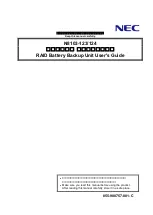
9
VEC1090 A
REV101103
ALTERNATOR VOLTAGE CHECK
ALTERNATOR VOLTAGE CHECK
PART 1: No Load
(turn OFF all accessories): The battery must be fully charged before testing the alternator. Run the engine
long enough to achieve normal idle speed and verify there is a no-load voltage.
1) PRESS Alternator Check to start the check.
2) After 5 seconds, PRESS the ON/OFF button to stop the test.
3) If the ALTERNATOR GOOD LED lights, then press the ON/OFF button to STOP the test.
PART 2: Under Load
(accessories ON): Next, load the alternator by turning on as many accessories as possible (except
for A/C and DEFROST)
1) PRESS Alternator Check to start the test.
2) After 5 seconds, PRESS the ON/OFF button to stop the test.
3) If the ALTERNATOR GOOD LED lights it is likely that the alternator is “good.”
If the first alternator check indicates a good alternator and the second indicates the alternator is bad, the problem could stem
from: loose fan belts, an intermittent diode failure or possibly bad connections between the battery and alternator and/or
ground.
CARE AND MAINTENANCE
With minimal maintenance, the VEC1090 A 2/10/20A Smart Battery Charger, will provide years of dependable service.
Follow these simple steps to maintain the charger in optimum condition:
• After each use, clean the battery charger clamps - be sure to remove any battery fluid that will cause corrosion of the
copper clamps.
• Clean the outside case of the charger with a soft cloth and, if necessary, mild soap solution.
• Do not allow liquid to enter the charger. Do not operate when charger is wet.
• Keep the charger cords loosely coiled during storage to prevent damage to the cords.
• Do not use charger if cords or clamps have been damaged in any way - call Vector Technical Support Department
toll-free: (866) 584-5504 to replace cords and clamps.
NOTE:
This check may not be accurate for every make, manufacturer and model of vehicle. There is wide variation
in user-controlled electrical loads, alternator output and wiring. Other factors include battery condition,
temperature, and engine idle speed. It is recommended to check your alternator when it is known to be
operating properly to verify that this check is valid for your particular vehicle. Check only 12V systems.
Checking 24 or 36V systems will damage charger.
NOTE:
: It may be that someone has added a number of accessory loads on the charging system, thereby
increasing current demand from the alternator.
MAKE SURE THAT THE ALTERNATOR IS RATED TO THE APPLICATION.
NOTE:
: Do not charge the battery while waiting for the engine to warm. This will invalidate any alternator
check. The digital display should show the circulating pattern while the engine is warming.
Do not turn on A/C or the defroster system to load the alternator. These accessories may start
operating during a test sequence and give an invalid result.






























